“There is always a rash of kidnapping and abductions of schoolchildren in the football months. Preteens of both sexes are traditionally seized and grabbed off the streets by gangs of organized perverts who traditionally give them as Christmas gifts to each other to be personal sex slaves and playthings. Most of these things are obviously Wrong and Evil and Ugly — but at least they are Traditional.”
When the internet broke traditional filtration methods of print, radio, and television it created a rift of instability within reality. Until then society had also been governed by an oligarchy, this is true, but while greedy and corrupt, at least they didn’t ritually abuse children too. . .right? Who could be so sure of this anymore.
The brief mass exposure the internet has given to sausage making traditions within politics is one of many reasons why the internet, as mechanism for transparency, has been gradually diagnosed with a manic disorder, and we are now hearing calls for the straitjacket come from all those institutions stripped of credibility due to the free flow of information through the porous net.
This information has been leaking ever since the nineties and a whole generation of those willing to look have been exposed to it forever. Corporate controls has been desperately plugging the gaps for at least over a decade now. And we probably have another decade more before the internet is unrecognisable. A suite of sanctioned websites for every interest and activity. After that everything will eventually return to normal and this entire period of free information, everything exposed by it, will be covered up in standardised history by analysing it as “era of misinformation”. Art and media dealing in this era will come to reflect this characterisation of it too, with the usual sycophantic hack archetypes becoming the most venerated in popular culture by the same corporate media interests they unconsciously cover up for.
But until that time comes, disinformation sites like this can continue last gasp attempts at misinformation surrounding why it is oligarch pet prodigies, such as Peter Montgomery Buttigieg, would not only pretend to be gay to circumvent the political zeitgeist, but in all likelihood prepare for job interviews by attaching self-compromising blackmail to their own resume.
This piece is long, beginning in Mesopotamia as a gestation period for three Canaanite traditions: the substitution sacrifice of a dying god, the child sacrifice of passing through fire, and sacred prostitution rituals involving group sex. It then follows the cultural diffusion of these traditions into Greek civilisation via the prophet Orpheus, also known as ‘Orpheus, the first pederast’, who founded the Cult of Dionysus and added a child sex tradition. Then from Greek tradition onto the Roman Cult of Mithras, a progenitor group influencing three social sects which developed into Western civilisation: elite secret society, european monarchy, and christian monotheism. And finally it ends with the vestiges of these traditions lingering tacitly in contemporary society in the form of elite paedophile rings, before going off the rails into a more personal paranoia surrounding Eyes Wide Shut and Stanley Kubrick’s death. Oh, and along the way we learn about the true spirit of Christmas!
Mesopotamia
So beginning in Neolithic Mesopotamia, the cradle of civilisation prior to 5000 BC, there were two types of people living in two distinct geographic regions:
1)A warlike patriarchal group of hunter-gathers who worshipped a sky god, the Sun. They worshipped the Sun because its daylight allowed them to hunt and gather. They lived in flatland regions, so can be called flatlanders.
2)A peaceful matricidal group of gardeners who worshipped a fertility goddess, the Earth. They worshipped the earth because its fertility produced their food. They lived in mountainous regions, so can be called highlanders.
When the highlanders eventually settled along river valleys, the combination of their gardening culture and the soils rejuvenation due to seasonal flooding lead to agriculture and population expansion within fixed long-term settlements, which culminated in city life to constitute the first ever civilisation.
The first form of governance within this civilisation emerged from a group of astrologers, who by studying the Suns movement were able to predict flooding events. They then provided this information to farmers in exchange for an early form of tax. The taxes collected gave them a surplus of what society producer, which they were able to put towards public works such as roads or irrigation ditches. Simply put, this priesthood of astrologers could predict the future using specialised knowledge food producers relied upon to avoid disaster. Such a thing would be akin to a modern institution, perhaps some kind of international banking institute, which could ‘predict’ market crashes using specialised knowledge.
This was formative of Mesopotamian Civilisation, which became a mixture of highlanders and flatlanders. Their respective deities, the patricidal archetype of the sky god, the sun, and the matricidal archetype of the fertility goddess, the earth mother; came to co-inhabit the same spiritual space and formed a god / goddess relationship.
Because the sun would rise and fall in cycles, and crops too would grow and die in cycles, the sun god evolved into the idea of a dying god ceaselessly being resurrected, along with a growing superstition for the mechanism by which it rose and fell, mostly out of an anxiety for it possibly falling to never rise again. So arose an expansive range of religious practises predicated on this idea of resurrection. That when the Sun fell, it died, and when it rose, it resurrected. This is also fundamental to an idea of immortality conquering death, manifesting in a masculine notion of virility, or growth. The sun god for this reason is called the dying god. It rises, dies, resurrects in cycles.
The earth mother became associated with the dying god as an explanation for its resurrection. The fertility of soil gives birth to a new cycle of crops. Women give birth to a new cycle of humans. Thus the earth mother resurrected the dying good as its lover, mother, or both.
Along with these two archetypes was an expansive and decentralised network of spiritual beliefs called animism, which attributed different spirits to different animals worshipped by different groups. Because the earliest form of governance was a centralised spiritual authority, the consolidation of its power as society incorporated more groups meant the consolidation of those groups spirit animals. Which lead to the creation of deities worshipped in the image of idols made up from a mixture of animals.
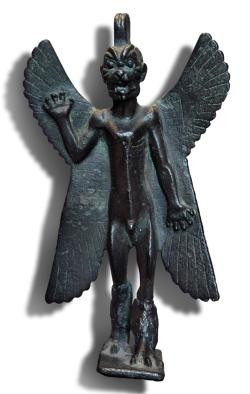
Pazuzu Artifact
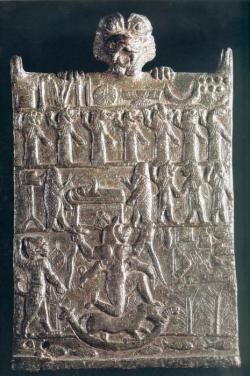
Lamashtu Artifact
Two of these were an early pair of Mesopotamian deities called Pazuzu and Lamashtu. The Pazuzu deity pictured above to the left, or top if you are on mobile, probably evolved from a society made of groups that had worshipped a lion, eagle, scorpion, and snake respectively. Then at some point these mixed animal deities evolved towards the image of men or women. This was probably due to a need for more ‘human’ intervention by priesthood authorities struggling to manage the expansion of their societies. Formerly, the priesthoods had to finesse the interpretation of natural phenomenon, such as weather events, only some of which they could predict. By placing the image of god into that of a king or queen, they created a dictatorial institution called Monarchy, that functioned as a perfunctory vessel controlled through such rites as coronation.
So Mesopotamia's spiritual evolution was vaguely:
- Two core deity archetypes, the dying god and earth mother, formed from flatland and highland people. Along with a wide range of animal spirits worshipped in decentralised social units.
- A smaller range of mixed animal deities worshipped by societies.
- Animal human hybrid deities worshipped more broadly.
- Human gods
These animal human hybrid deities eventually became apart of mythologies, such as the Mesopotamian epic of Gilgamesh around 2 BC. In this story are the origins of a goddess which would take many names and forms, but whose symbol would remain an eight-pointed star, later known as the Star of Ishtar. This eight pointed star was associated with Lamashtu, and can be seen in the above image at the top slightly left of centre. The following is a translation of a cuneiform incantation Mesopotamians thought would protect them from Lamashtu:
Lamash, daughter of Anu
Whose name has been uttered by the gods
Innin(Inanna), queen of queens
Lamashtu, O great lady
Who seizes the painful Asakku
Overwhelming the ‘Alû
Come not nigh what belongeth to the man
Be conjured by Heaven
Be conjured by the Earth
Be conjured by Enlil
Be conjured by Ea 1
Here we see the mixed-animal deity Lamashtu identified also as a human-animal hybrid goddess Inaana. Lamashtu evolved into a more human image identified as a female goddess called Inanna.
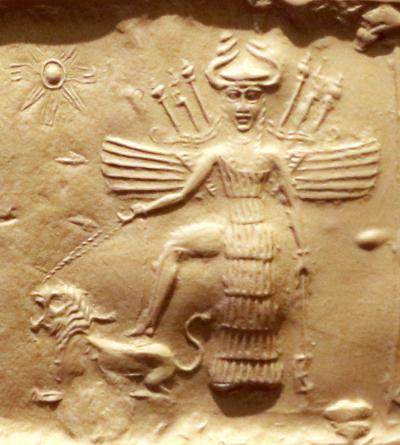
Artifact depicting Inanna, notice the the eight pointed star in the top left.
But there are differences between the two also. Some slight variations, such as standing on a different animal with one foot instead of two, or more overt ones such as Inanna having a human head with horns as opposed to a dogs head or lions, as did Lamashtu. The deities worshipped in Mesopotamia morphed over time to suit the immediate needs of its evolving civilisation. What these needs were is hard to say, though probably political in most instances. So this need for abstraction created multiple versions of goddesses and gods under different names and of various forms, but also with persistent core traits. We could call this tweaks. But these tweaks lead to confusion when trying to distinguish between different deities of the same name, or the same deities of different names. It doesn’t help that once we move into Classical civilisation, being Greek and Roman, there becomes a concerted effort to invoke such confusion. But we can be confident that Lamashtu became Inanna.
The Sumerian poem, Gilgamesh and the Bull of Heaven, introduces the goddess Inanna in more detail, giving her an origin story involving a bull. The later inclusion and retelling of this story in,The Epic of Gilgamesh, gives even more detail, but refers to Inanna under the name Ishtar. Ishtar is a Canaanite goddess. In this account Ishtar sends a bull to kill Gilgamesh, who slays it, tears it apart, then throws the pieces back at her. So the Sumerian Inanna is the same goddess later called Ishtar by the Canaanites. The two are synonymous, and whom Babylonian astrologers associated with the planet Venus.
Lamashtu > Inanna > Ishtar.
All three are associated with the same symbol of an eight-pointed star, which the Babylonians called the Star of Ishtar. Ishtar’s origin story associates her with a bull, which is torn to pieces thrown back to her. The Canaanite deity Moloch, was worshipped by the Carthaginians in the image of a bull. But more on this later.
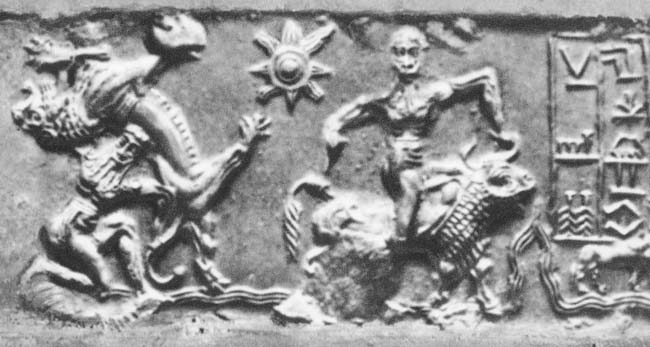
Artifact depicting Star of Ishtar and the killing of a bull.
The planet Venus and bull came to symbolize earth mother and dying god archetypes within Canaanite civilisation, which was also the first civilisation ever governed by a commercial oligarchy. In Mesopotamian civilisation, society had been governed by a priesthood who figured out specialised knowledge pertaining to the seasonal flooding allowing them to tax farmers. Canaanite society on the other hand developed into a commercial oligarchy due to being centrally situated between other producing societies, making it a trade nexus. Its trade nexus status meant merchants, as opposed to farming producers, generated the bulk of the surplus wealth generated in the society. Due to this, priesthood governance waned to incorporate the new power structure of merchants. Since it was a commerce orientated society, it developed a collection of commercial families which came to monopolise the surplus wealth being generated. And these families became the first historical instance of a mercantile oligarchy.
Canaanite
Canaanite civilisation can be sequestered into two branches distinguished by its two main cities. These were Carthage and Babylon, each worshipping a separate pairs of deities derived from the earth mother and dying god archetypes. From these they developed separate religious practises, which bleed into two separate branches of ritual tradition diffused from Canaanite culture into Classical culture, that being Greek and Roman.
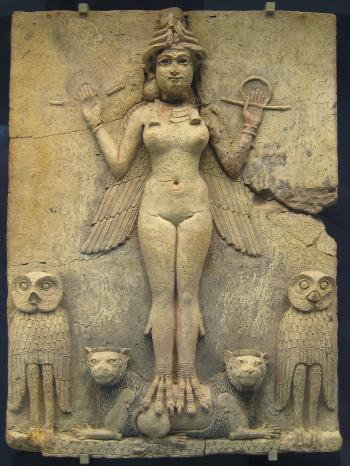
Artifact depicting Ishtar.
Babylon worshipped the patron deities Ishtar and Tammuz. Ishtar, depending on the period, was also known as Inanna or Sarpanit, but was associated with the planet Venus broadly speaking. Her symbol was an eight-pointed star called the star of Ishtar, and would later become known to monotheists as the Whore of Babylon. Her consort was Tammuz, also known as Marduk, Bel, or Dumuzid, who represented the the planet Jupiter. Religious rituals surrounding these two deities involved sexual rites known as sacred prostitution, or sex magic. These rituals were performed as reenactments of Ishtar's mythologised origin stories. In one of these myths a dying god archetype called Thammuz is resurrected by Ishtar through baptism, making her an earth mother archetype:
“In Babylonian legend, the goddess Istar descends to Hades to fetch the water of life with which to restore to life the dead Thammuz, and it appears that the water was thrown over him at a great mourning ceremony, at which men and women stood round the funeral pyre of Thammuz lamenting.” —The Golden Bough, James G. Frazer vol I, p287. 2
The Babylonians also held an annual festival called Sacaea, which went for five days and ended with a resurrection ritual where a human sacrifice taking on the role of the king, who had come to represent a dying god, was whipped and then crucified.
“According to the historian Berosus, who as a Babylonian priest spoke with ample knowledge, there was annually celebrated in Babylon a festival called the Sacaea. . .During these five days masters and servants changed places, the servants giving orders and the masters obeying them. A prisoner condemned to death was dressed in the king’s robes, seated on the king’s throne, allowed to issue whatever commands he pleased, to eat, drink, and enjoy himself, and to lie with the king’s concubines. But at the end of the five days he was stripped of his royal robes, scourged, and crucified." —The Golden Bough, James G. Frazer, vol I, p226. 2
Another annual Babylonian festival, which went for twelves days in December, was called Zagmuk. It involved sacred prostitution rites using priestesses from the Temple of Venus in Babylon representing Ishtar, who would have ritualistic sex with the king, representing the dying god Tammuz, who would then be killed afterwards. Though they would come to use a substitution sacrifice in the place of the king to circumvent having to ordain a new leader annually. 3
So we have three religious traditions happening in Babylon and closely associated with Ishtar around 2 BC:
- A ritual reenactment of a resurrection through baptism.
- A ritual of death and resurrection using a human sacrifice who is whipped and then crucified
- A ritual of sacred prostitution performed during a twelve day festival held annually in December
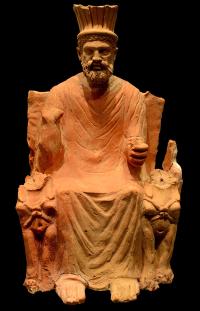
Baal Hammon Artifact
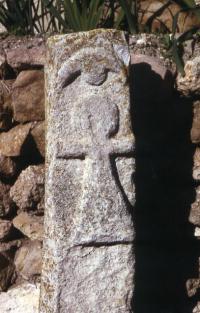
Sigil of Tanit found near a tophet
In Carthage the traditions weren’t so merry. The Carthaginians worshipped the deities Baal Hammon(left/top) and Tanit(right/bottom). Baal Hammon also went under the moniker Moloch, El, or indistinctly just Baal, and was associated with the planet Saturn. As an idol, he was worshipped in the form of a large bronze bull with giant outreached hands which sloped down into the open pit of a stomach which blazed as a furnace. His female consort was Tanit, a goddess perhaps associated with the moon though this is unclear, and she was symbolised as a deity with a lions head and by the sigil of her name, which looks like the womens restroom symbol. The religious rituals surrounding these deities involved child sacrifice, or passing children through flames.
“When the Carthaginians were defeated and besieged by Agathocles, they ascribed their disasters to the wrath of Baal; for whereas in former times they had been wont to sacrifice to him their own children, they had latterly fallen into the habit of buying children and rearing them to be victims. So, to appease the angry god, two hundred children of the noblest families were picked out for sacrifice, and the tale of victims swelled by not less than three hundred more who volunteered to die for the fatherland. They were sacrificed by being placed, one by one, on the sloping hands of the brazen image, from which they rolled into a pit of fire.” — James G. Frazer, The Golden Bough, vol I, p236. 2
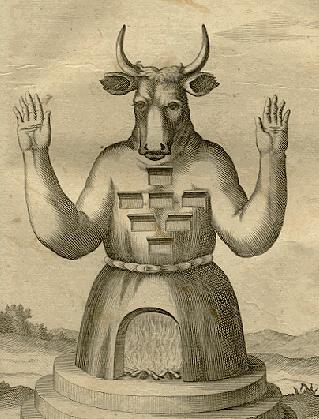
"The idol Moloch with seven chambers or chapels", from Johann Lund's Die Alten Jüdischen Heiligthümer (1711, 1738)
“Their organisation of expansion was the same institutionalised commercial capitalism. Their religion was clearly Canaanite, full of bloodthirsty superstitions concerned with various ‘baals,’ especially Moloch. This god, who was worshipped by throwing infants into his raging fires, was the principal deity of Carthage and Tyre and was not unknown in Palestine; there Solomon erected an alter to him, and other Israelites joined in his horrible sacrifices.” — Carroll Quigley, Evolution of Civilisations: An introduction to historical analysis, p254. 4
These accounts were heavily contested in the 20th century, discredited as smear campaigns perpetrated by Greek and Roman historians. However, modern archaeological digs, such as those done in the ancient port city of Vagarit, discovered the ruins of tophets, mass burial tombs filled with piles of child sized bones. tophets have been discover only in regions where Moloch and Tanit had been worshipped, which would confirm the Roman and Greek accounts — “But when you pull together all the evidence – archaeological, epigraphic and literary – it is overwhelming and, we believe, conclusive: they did kill their children, and on the evidence of the inscriptions, not just as an offering for future favours but fulfilling a promise that had already been made. . .This was not a common event, and it must have been among an elite because cremation was very expensive, and so was the ritual of burial. It may even have been seen as a philanthropic act for the good of the whole community." 5
The sacrifices made to Moloch appear rather uncommon, though also exclusive to oligarchic families of Carthage, including a few other regions such as Tyre or Palestine where the deity was worshipped too. That these families cheated the system by raising other peoples children for this purpose, is illustrative of a common tradition found throughout Canaanite culture, which was a temporary inversion of cultural norms to facilitate substitution sacrifice. The Carthaginians substituted their children with others, they would raise as their own for this purpose. The Babylonians substituted their King for another, who would be given all the kingly privileges for a period of celebration leading up to their death.
This idea of role inversion, perhaps originated from an issue which arose when religious governance evolved to embodied the actual god within a man, creating a man-god, which is simply just a King who rules through divine authority. The problem here being that gods are meant to be immortal, and men are not. As previously mentioned, the earliest male deity was that of the Sun, which represented a dying god that had to be resurrected. Once the dying god was given the image of a man, the dying god started to be resurrected through a practise known as the killing of the king. This was the ritual killing of a king so that the god they embodied could be resurrected in a younger host. Since the dying god represented virility and strength, once this god became embodied within a man, that man needed be virile and strong. Depending on the culture, signs of ageing were indications to the various religious authorities it was time for a new host. Over time a loophole was worked in to preserve the stability of a King’s reign, whereby the king would periodically relinquish their role, perhaps annually, during which time their privileges and duties would be transferred to another, who would be sacrificed instead, and the dying god would then be resurrected in the king who had temporarily relinquished their rule.
So the Canaanite religious traditions practised by a commercial oligarchy in the cities of Carthage and Babylon were:
- sacred prostitution
- resurrection through baptism
- whipping and crucifixion of a human sacrifice
- role inversion festivals to circumvent killing the king as the dying god
- child sacrifice for good fortune
- raising other people's children as a substituion sacrifice
Greek
The Greeks sacked Tyre, a third major Canaanite city, in 332 BC. Alexander the Great had spared Babylon such a fate the year prior in 331 BC. Rome eventually sacked Carthage during the third punic war in 146 BC.
During this period Canaanite mythology began to diffuse into Greek mythology through poet prophets such as Homer or Orpheus, and Canaanite religious traditions began to manifest in new forms within a series of elusive rites practised by what are called the Greek mystery cults, which were very early quasi-secret societies used to perpetuate, tacitly, traditions gradually becoming taboos.
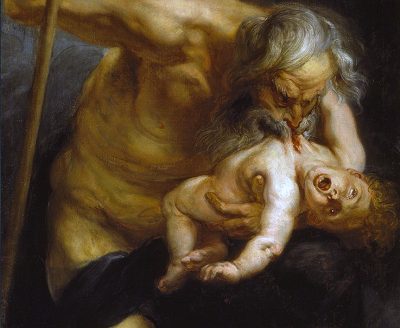
Cronus devouring one of his children
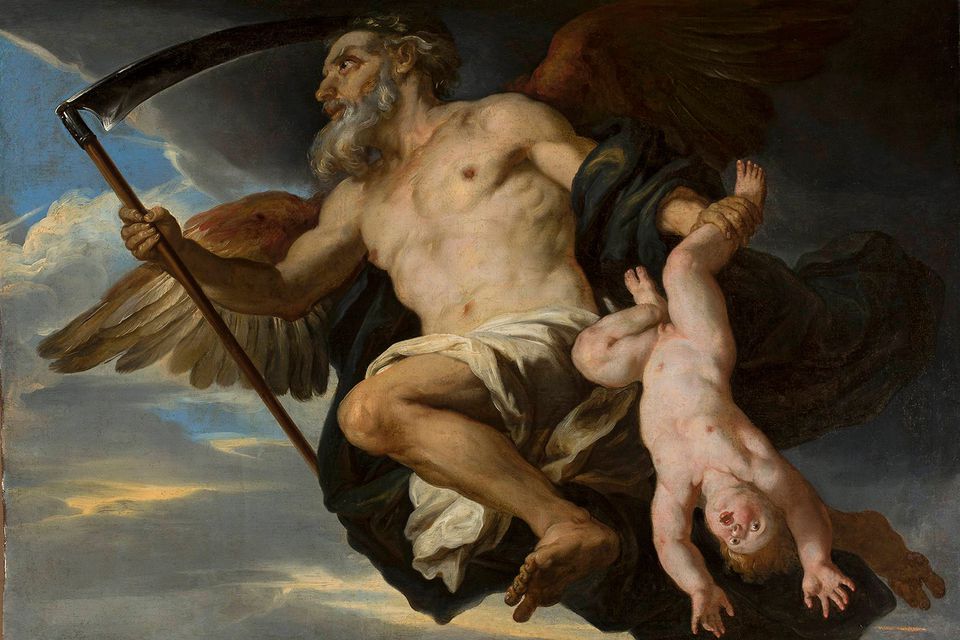
Cronus with his child
Some of the religious diffusion from Canaanite to Greek is rather clear. Ishtar became a number of goddesses associated with fertility or sex, primarily Aphrodite, the goddess of Venus. Her consort Tammuz became Adonis and remained a dying god archetype. Baal Hammon(Moloch, Saturn) became Cronos, the god of Saturn, though he may also have taken a more secretive form which we’ll get to. His consort Tanit became Rhea, the moon goddess who was Cronos’ sister/lover in Greek myth, and perhaps the later inspiration for the Virgin Mary:
“It was not until the eleventh century that the old Virgin Goddess Rhea, mother of Zeus and now identified with the Mother of Jesus, began to be honoured with all her old titles and attributes” — Robert Graves, The White Goddess, p351. 6
The Babylonian festival Sacaea became the Greek festival Kronia in celebration of Cronos(Baal Hammon/Moloch). It was held during the same time of year, with its chief characteristic being role inversion between masters and slaves in the substitution sacrifice tradition. Kronia in turn would be celebrated under the name Saturnalia in Rome, which is the festival often referenced as the historical origin of Christmas, but following the cultural heritage further back is to give the sequence: Sacaea > Kronia > Saturnalia > Christmas.
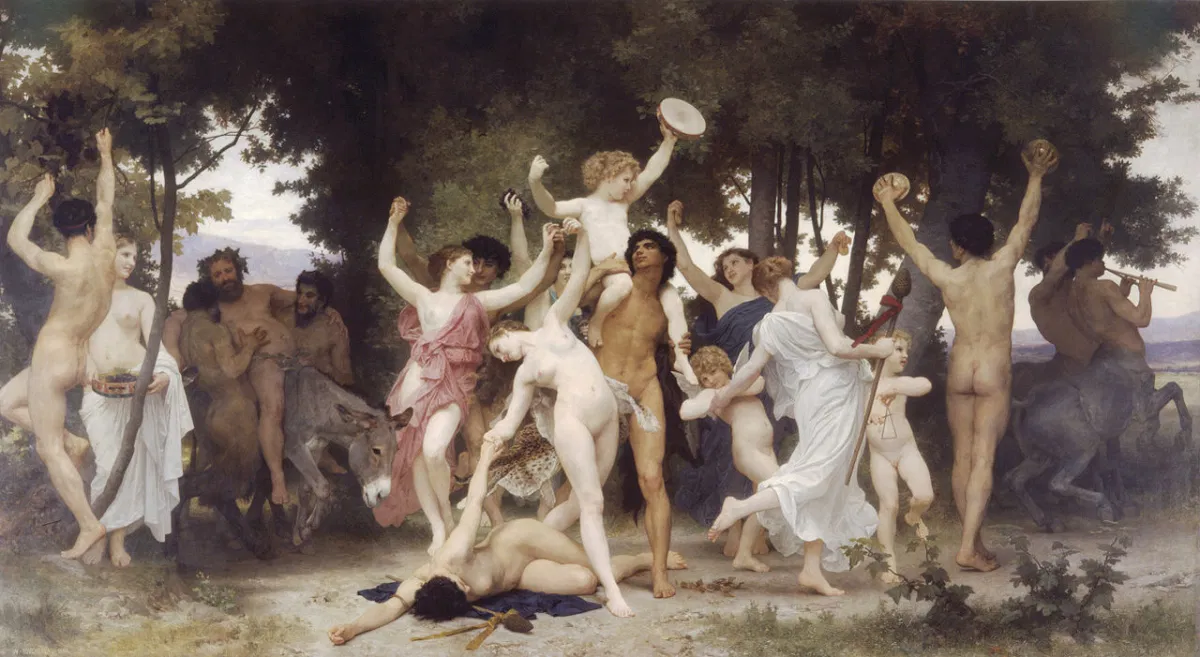
Of all the Greek mystery cults the most intriguing is that of Dionysus. He was the god of wine among other things, and had a particular association with pine trees, being often depicted carrying a wand tipped with a pine cone. His origin myth is the classic dying god being resurrected. He was torn apart into limbs by the titans, just like Ishtar’s bull, and his mother put all the pieces back together again to resurrect him. Who his mother was is unclear. Though some Greeks who worshipped Dionysus seemed to believe it was Rhea(Tanit, consort of Baal Hammon/Moloch):
“Sabazian Zeus and Sabazian Dionysus were different names of the same character, the Son of Rhea; which means that he was of Cretan origin.” — The White Goddess, Robert Graves, p274. 6
If the Cult of Dionysus worshipped him as the same deity as Zeus, but of another name and form, then according to his origin story he was the son of Cronos(Moloch) and Rhea(Tanit), meaning the Cult of Dionysus was possibly a perpetuation of Carthaginian religious rites, such as child sacrifice, which was not unknown to the Greeks. Pertinent to this was Dionysus being worshipped in the form of a bull:
“A feature in the mythical character of Dionysus, which at first sight appears inconsistent with his nature as a deity of vegetation, is that he was often conceived and represented in animal shape, especially in the form, or at least with the horns, of a bull. Thus he is spoken of as ‘cow-born’, ‘bull’, ‘bull-shaped’, ‘bull-faced’, ‘bull-browed’, ‘bull-horned’, ‘horn-bearing’, ‘two-horned’, ‘horned’. He was believed to appear, at least occasionally, as a bull. His images were often, as at Cyzicus, made in bull shape, or with bull horn; and he was painted with horns. ” —The Golden Bough, James G. Frazer vol I, p325-p326 2
Rites performed by the Cult of Dionysus involved a reenactment of his origin myth, where a live bull was torn to pieces and eaten raw in a sort of frenzied banqueting ritual, “his worshippers believed that they were killing the god, eating his flesh, and drinking his blood”. 2
James G. Frazer, the source for this, while ultimately believing that worship of Dionysus as a bull was just another expression of his agricultural aspect, is also open to the possibility that:
“The other possible explanation of the bull-shaped Dionysus would be that the conception of him as a bull was originally entirely distinct from the conception of him as a deity of vegetation, and that the fusion of the two conceptions was due to some such circumstance as the union of two tribes, one of which had previously worshipped a bull-god and the other a tree-god. This appears to be the view taken by Mr. Andrew Lang, who suggests that the bull-formed Dionysus ‘had either been developed out of, or had succeeded to the worship of a bull-totem’” —The Golden Bough, James G. Frazer vol II, p37 2
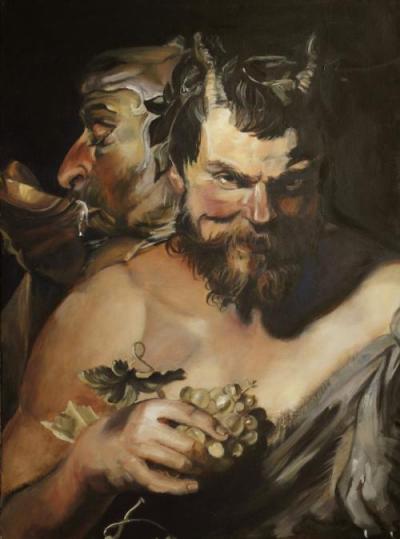
Two Satyrs 1618 Peter Paul Rubens
Dionysus was also worshipped in the image of a goat but another sect or cult. This led to an association of lesser deities such as Pan, Satyrs, or Silenus with him. The rites performed by his goat cult likely served as the historical origin to a later paranoia surrounding witches covens in greater Europe:
“Meantime it remains to point out that in some places, instead of an animal, a human being was torn in pieces at the rites of Dionysus. This was the custom in Chios and Tenedos; and at Potniae in Boeotia the tradition ran that it had been formerly the custom to sacrifice to the goat-smiting Dionysus a child, for whom a goat was afterwards substituted.” —The Golden Bough, James G. Frazer vol I, p329 2
The sacrificial rituals involving children appear limited to only those subsets of Dionysus cults who worshipped him in the image of a goat or bull. Dionysus was more broadly worshipped as an innocuous agricultural god. A god of the vine and general vegetation, but too a god of cultivated trees, particularly the pine-tree.
“The Delphic oracle commanded the Corinthians to worship a particular pine-tree, ‘equally with the god’ so they made two images of Dionysus out of it, with red faces and gilt bodies.’ —The Golden Bough, James G. Frazer vol I, p322 2
A pine tree decorated in gold is a Christmas tree. So emerging from the various forms of Greek worship of Dionysus emerge two very contrasting branches of spiritual tradition. One openly practised still to this day, and another of the Canaanite tradition gradually becoming taboo. Which could explain why he was also called the masked god, the god of a dual nature, a god embodying the tenet of duality. This is the expression of the occultist maxim, 'As above, so below', which was also symbolised by a gesture of the raised right hand and lowered left, also seen given by the aforementioned Mesopotamian deity Pazuzu.
The Cult of Dionysus was founded by the Greek poet prophet Orpheus, also known as ‘Orpheus, the first pederast’. According to the Roman poet Ovid, Orpheus was the trend setter for Greek paedophilia:
“. . .had abstained from the love of women, either because things ended badly for him, or because he had sworn to do so. Yet, many felt a desire to be joined with the poet, and many grieved at rejection. Indeed, he was the first of the Thracian people to transfer his affection to young boys and enjoy their brief springtime, and early flowering this side of manhood.” — Ovid, Ovid: The Metamorphoses, Book X.
Much of the historical depictions of the Cult of Dionysus, accounted for in paintings and such, often feature naked children partaking in orgiastic festivities alongside adults. So it would be fair to assume the Cult of Dionysus incorporated paedophilia alongside the sacrificial ritual, probably in the lead up to, given the festival traditions they adapted from the Canaanite culture.
These ritualistic orgies were a rite of Dionysus practised by a sect called the Maenads. It was what we would be familiar with as a witches cult, being all women, who worshipped Dionysus as bull or goat. Orpheus was even supposedly killed according to the Maenad rites of Dionysus. They tore him to pieces during a possession orgy, drank his blood and ate his flesh.
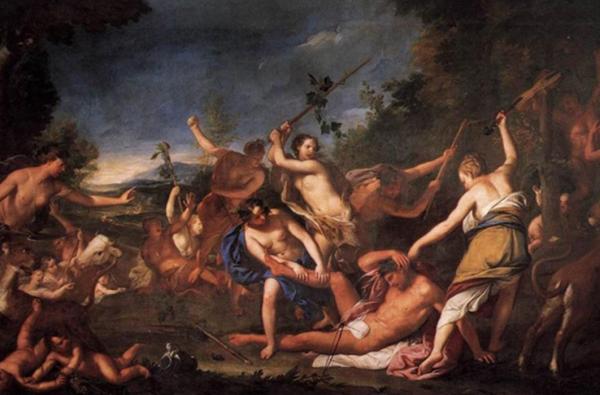
The Maenads tear Orpheus apart
It isn’t difficult to see how Christian paranoia for Satanism germinates from these historical accounts, which are not biblical in their origin. However, they did come to develop general paranoia for anything beyond their own narrow spiritual framework. Becoming quick to condemn innocuous pagan practises with the more grotesque, most of which simply encouraged spiritual harmony with nature, such as those who worshipped Dionysus as merely an agricultural god. Though there is inversely also the assumption, quite popular in these secular days, that all polytheist practises are benign or enlightened, and that all evidence supposing otherwise is one grand historical hoax perpetrated in a conspiratorial manner by the institution of Church. In reality, like with most things, the truth falls somewhere between two extreme ends of a spectrum bickering over the absolute presence of, or absolute absence of, any certain phenomenon.
So to summarise before we diffuse into Rome:
Canaanite Ishtar (Venus) became Greek Aphrodite(Venus)
Canaanite Baal Hammon/Moloch (Saturn/Bull) became Greek Cronos(Saturn)/Dionysus(Bull or Goat)
Canaanite Tanit (Lion/Moon) became Greek Rhea (Lion/Moon)
Babylonian festival of Sacaea (role inversion theme) became Greek festival Kronia (Saturn/role inversion theme)
The Cult of Dionysus:
- Founded by the Greek pederast Orpheus.
- Worshipped Dionysus as a bull or goat, who in his origin story is torn to pieces, just like Ishtar’s bull in the Gilgamesh epic that predated Greek mythology.
- Ritual of tearing apart a live bull, eating its flesh and drinking its blood. This predates the monotheist ritual of holy communion, eating the body of, and drinking the blood of Christ.
- Often instead of a bull, a human sacrifice or child was used.
- Children were likely involved in the ritual orgies.
Roman
When Greek civilisation bled into the Roman Empire, the traditions became institutionalised and simplified beneath the orderly structure of a militarist regime. Though this did became confused when it incorporated an Egyptian spiritual aspect, leading to the conflation of various sets of earth mother/ dying god archetypes. From this originates an historical interpretation working to veer modern investigations into the roots of Western spirituality, away from an origin in Canaanite traditions via the Greeks, and towards an origin of Egyptian mythology. Such a thing is the motivation behind a modern emphasis on packaging UFOlogy and Egyptian mysticism together in a compensate for the spiritual void torn into contemporary culture, and culminating in religious programming such as history channel shows like ‘Ancient Aliens’. This movement as a whole could be labelled hermeticism, which is an occultist alternative or revisionist history, or ‘super secret history’, which goes back to Greek mythology to illuminate a continuity between it and Egyptian mythology, which of course had the same earth mother and dying god archetypes as Canaanite civilisation.

ALeister Crowley all dressed up
Aleister Crowley and other proponents of the occult hermetic orders, such as the Hermetic order of the Golden Dawn, have been extremely influential behind the scenes within various 20th century artistic disciplines, most notably rock bands, who if nothing else are guides to a form of spiritual ritual called dance. Symbols of Egyptian mythology can be spotted everywhere these days. The eye of Ra or Horus can be spotted in music videos, or as tattoos on secular women looking to express a spiritual secret. It has also become the leading iconography of Illuminati pop culture, indulged in by those who believe they are privy to the modern form of an 18th century conspiracy.
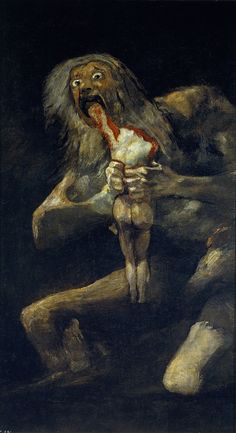
Saturn devours his children
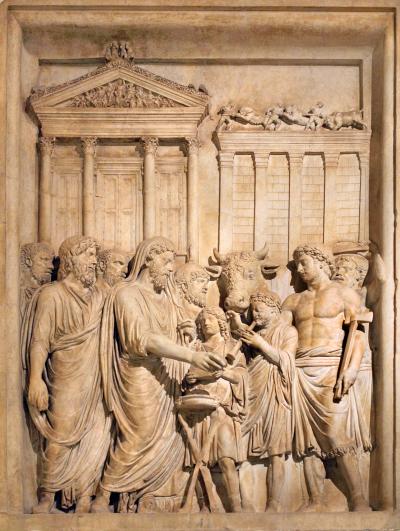
Saturnalia sacrifice of bull. . .or that child in the middle, subtly held by the man with the axe to the right.
The Romans, being matter of factly, stripped away the Greek names and went with the planets themselves as identifiers. Aphrodite became the Goddess Venus. Cronos became Saturn. Those Greek gods not so closely associated with planets, such as Dionysus(perhaps Moloch as Bull/goat) or Rhea(Tanit as Lion), became cloaked within a collection of new Roman mystery cults, similar to the Greek cults. However, since Roman taboos were much more strict than Greek, the rites practised by these cults, should they wish to continue them, had to be done in more clandestine ways. This need to perpetuate taboo traditions spurred the development of a more secretive tradition of worship. Things such as secret underground temples, secretive texts, unspoken but mutual understandings, use of double entendres in the expression of religious iconography through art or idolatry; were all cultural traits constituting a new social unit of insular secret socialites defined by a secretive culture. These secret societies served not just spiritual needs, but the need for trust in human relationships too, which bleed beyond the religious realm to serve a purpose in commerce and other such dealings.
Generally speaking, as a culture becomes rigid, it conforms externally to new norms, but also circumvents them internally within black markets; a phenomenon observed in almost all popular human behaviours which have become outlawed. And so this must also be true of spiritual ones, as spirituality is a basic human need which cannot be suppressed.
The Greek festival Kronia became Saturnalia(Sacaea>Kronia>Saturnalia), which was of course named after the Roman god Saturn(Moloch/Baal Hammon>Cronos>Saturn). Though instead of being held in June/July like the previous two, Saturnalia was a twelve day festival beginning on the 17th of December. The duration was later shortened to cease on the 23rd of December. The key indication Saturnalia was a continuation of the same tradition first observed as the Sacaea is the central theme of role inversion under the banner of a god Saturn, this to facilitate the killing of the king ritual, who represented a dying god, using a substitution sacrifice.
Saturnalia is generally considered to be the tradition Christmas was modelled on. It’s held in December. Went for twelve days. Involved gift giving. And the theme of role inversion between master and slave persisted. There was the anointment of a mock king to preside over the festivities, who became known as the archetype of the ‘the fool’, as they were oblivious to their sacrificial fate at the festivals conclusion. Though new social norms for public celebrations supplemented tradition human sacrifice with animal sacrifice, and at Saturnalia they used a bull. It seems the Romans also circumvented sacrifice taboos by supplementing them with more palatable displays of sport, such is speculation surrounding the gladiatorial event calendar matching up to its festival calendar as an associated form of human sacrifice.
The sacrifices, or mock sacrifices during Saturnalia were held within the Temple of Saturn, which also housed the Roman treasury, and in this manner somewhat served as the Roman central bank. The column frontage of the temple still remains though the rest is gone. The Chicago Federal Reserve appears to have been built in its image, along with a number of Wall Street buildings such as federal hall and the NY stock exchange, which has the same six column frontage.
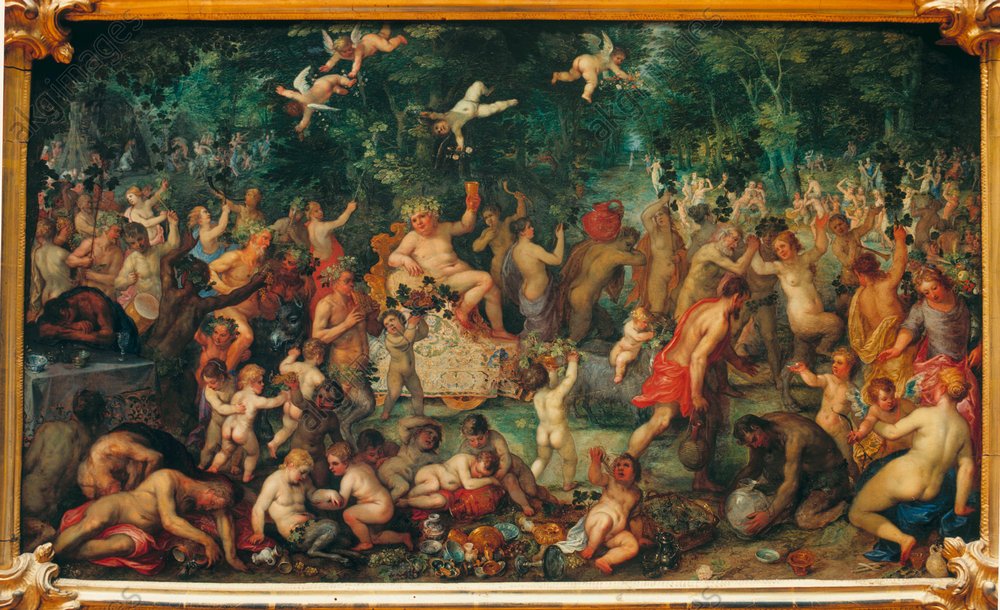
Bacchanalia
The rites of Dionysus as the image of a goat persisted into Rome under the name Bacchus, and the festival Bacchanalia, which involved similar ritualistic orgies and a general frenzy of debauchery. The cult of Bacchus, as it became known, was eventually outlawed by the Roman Senate, though persisted underground, probably in all its child sex and sacrificial orthodoxy, but also in reformed versions too.
Though in Rome there was also a new obscure cult surrounding the mysterious dying god archetype called Mithras, purportedly of Persian persuasion, closely associated with a bull or the Sun in iconography, and whose cults initiation rites appeared to perpetuate the same Greek Orphic rites of Dionysus:
“What, for the early Church Councils, seemed the most diabolical and unpardonable heresy of all was the identification of the Hercules-Dionysus-Mithras bull, whose living flesh the Orphic ascetics tore and ate in their initiation ceremony, with Jesus Christ whose living flesh was symbolically torn and eaten in the Holy Communion.” — Robert Graves, The White Goddess, p116. 6
Graves also gives his source for the contention Dionysus was actually Zeus, or vise versa, either way being the same son of Cronos(Baal Hammon/Moloch) and Rhea(Tanit):
“The clue is to found in the well-known Orphic formula:
‘Like a kid I have fallen into milk’
which was a password for the initiates when they reached Hades and were challenged by the guardians of the dead. They had become one with The Kid, that is to say the immortal Dionysus, originally Cretan Zagreus or Zeus, by partaking of his flesh, and with the Goat-Goddess, his mother, in whose cauldren and milk he had been seethed” — Robert Graves, The White Goddess, p182. 6
Further more,
“Nonnus, the Orphic writer, explains the shift in Crete from the goat to the bull-sacrifice by saying that Zagreus, or Dionysus, was a horned infant who occupied the throne of Zeus for a day. The Titans tore him in pieces and ate him after he had raced through his changes of shape: Zeus with the goat-skin coat, Cronos making rain, as inspired youth, a lion, a horse, a horned snake, a tiger, a bull. It was as a bull that the Titans ate him. The Persian Mithras was also eaten in bull form.”
— Robert Graves, The White Goddess, p183. 6The cult of Mithras had some interesting features on top of this. Underground temples, secret hand shakes, multiple grades of initiation pertaining to secret knowledge; all things which eventually manifest in the various sects of Freemasonry, various lodges of which laid claim to secret knowledge to the true origins of the common traditions practised among them all. Some sects traced things back to Persian influences, others Egyptian, which were hermetic orders, and of course some to the Canaanites. The Scottish Rite of Freemasonry could perhaps be the Canaanite interpretation of Freemason cultural linage, as in Scotland human sacrifice was practised up until a rather late period, at rituals known as the Beltane fires. These involved setting alight giant wicker idols full of victims, sacrificed in fire to carry good favour with a god they referred to as Baal(Baal Hammon, Moloch, Saturn):
“In the central Highlands of Scotland bonfies, known as the Beltane fire, were formerly kindled with great ceremony on the 1st of May, and the traces of human sacrifices at them were particularly clear and unequivocal. . .
they put all the bits of cake into a bonnet. Every one, blindfolded, draws out a portion. He who holds the bonnet is entitled to the last bit. Whoever draws the black bit is the devoted who is to be sacrificed to Baal, whose favour they mean to implore, in rendering the year productive of the sustenance of man and beast. The victim selected was called cailleach bealtane –i.e. the Beltane carline, a term of great reproach.” —The Golden Bough, James G. Frazer vol II, p256 2
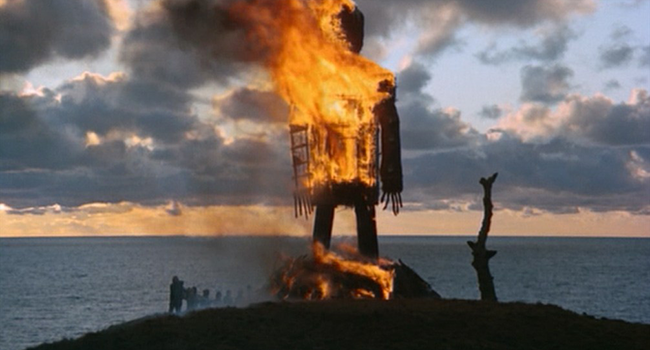
The Wicker Man, 1973
This is of course from where the Burning Man festival takes its theme. Though this topic is better explored through popular culture in the 1973 film, The Wicker Man. Its original cut would eventually get fucked around with in the editing room, with rights to the edited version bought and distributed by Warner Brothers in the US, with the original cut of the film apparently having gone missing 7. Warner Brothers were also involved in fucking around with Stanley Kubrick’s Eyes Wide Shut, which we later delve into.
According to Belgian historian Franz Cumont, whose research into the cult of Mithras had been authoritative for much of the 20th century, the highest level of cult initiation divulged the secret to Mithras’ true identity, which was that of the Leontocephaline.
The Leontocephaline is a mixed-animal human hybrid deity like the ones worshipped in Mesopotamia. It is lionheaded, winged, with a serpent coiled around its body, often with its right arm raised as if holding a torch or swearing on a bible. These characteristics are similar to those seen of Pazuzu, who is depicted with his right hand raised, lionheaded, with wings, and a serpents penis coiled around his lower half.

Pazuzu Artifact
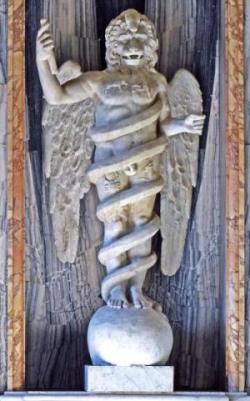
Leontocephaline
Pazuzu is the demon that possesses the girl in, The Exorcist. The opening scene of this film is set in modern day Iraq, where the priest discovers an artefact idol of Pazuzu during an archaeological dig. Iraq is where ancient Babylon was located. The Pazuzu pose, right arm raised left arm lowered, also known as an occult maxim ‘As above, so below’ is also the pose found in depictions of the Templar deity Baphomet.
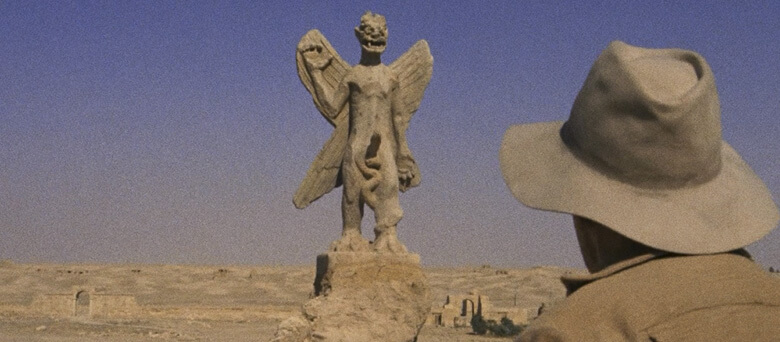
The final shot of Stanley Kubrick’s The Shining, is a hauntingly slow zoom into a real photograph he found in the BBC archives. The only alteration made to it was Jack Nicholson’s head pasted over the central figure's, whom is doing this same “as above, so below” pose for the camera. 8
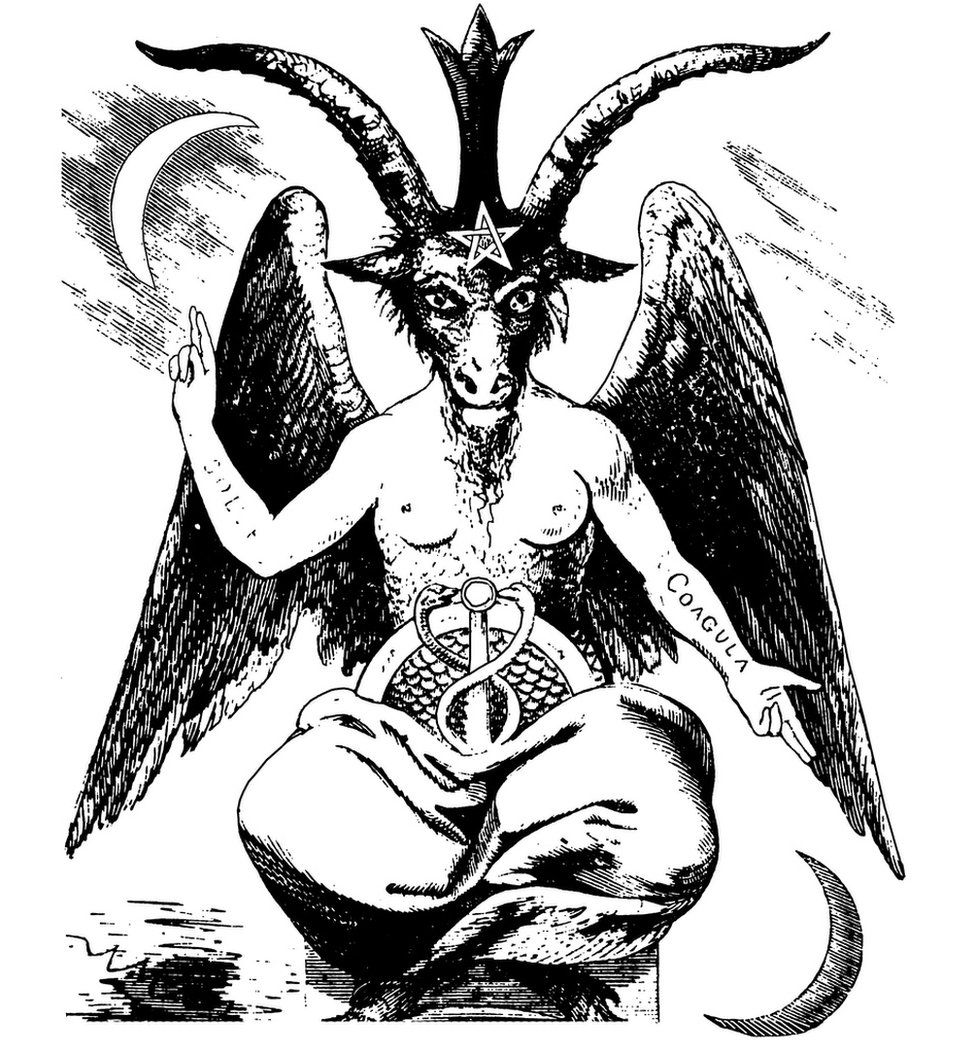

Mithras took other less secretive forms, predominantly within surviving iconography as a god crowned with sun rays, or a sun-god. Mithraism of this form became known as the Cult of Sol Invictus, which held an annual festival called ‘Dies Vatalis of Sol Invitus’ on the 25th of December, closely linked to Saturnalia as apart of the segue into Christmas. Mithras was also depicted often as a bull slaying god, making him analogous to Gilgamesh, who slayed Ishtar’s bull and tore it to pieces.
Roman emperors during the gestation of Christian orthodoxy were figure heads of this cult, which had gained an exclusive following within elite Roman society, particularly its military institution which moderated the power of the Senate, the slaveowner’s institution from the time Julius Caesar crossed the Rubicon. Thus, emperors from Augustus to Constantine are often depicted wearing spiked sun ray crowns, which became the traditional crown Western Monarchy.
It is also during this Mithraic period we get the figure of Jesus, the sun of god. A classic dying god archetype incorporating the all of the aforementioned traditions traced back to Babylon into a structured framework of orthodox practises under a single god.
Christian Baptism – The resurrection ritual performed during the Babylonian festival of Sacaea, relating to the mythology of their patron goddess Ishtar.
Holy Communion – The ritual performed by the Cult of Dionysus where they would eat the flesh of and drink the blood of, a bull or human sacrifice representing their dying god.
Christmas – The Roman festival Saturnalia held in December, originally for twelve days – twelve days of Christmas, involved gift giving and was a tradition continued on from the Greek Kronia, which had been the continuation of the Babylonian Sacaea or Zagmuk.
Christmas Tree – The agricultural version of the god Dionysus was worshipped as pine tree decorated with gold.
Crucifixion of Jesus – The ritual performed during Sacaea whereby the substitution sacrifice for the king, a ‘fool’ acting on their behalf as the embodiment of the dying god, was whipped and then crucified.
So who is this Jesus the Christians worship? He is a dying god archetype whose mother was a virgin, but with speculation she may have been a prostitute. He is whipped and crucified like a Babylonian dying god. His flesh and blood are digested like Dionysus as a bull. And he is baptised just as a Babylonian dying god had been by Ishtar as a form of resurrection.
Then there is the perplexing presence of a bull in many of the scenes depicting Jesus birth, even though such animal isn’t mentioned in the Gospel’s story, and for which the Catholic Church ostensibly have no explanation for. “’In the gospels there is no mention of animals,’ the pope states. He says references to the ox and the donkey in other parts of the Bible may have inspired Christians to include them in their nativity scenes. The Vatican itself has included animals in the nativity scenes it sets up each year in St Peter's Square, and Benedict concedes that the tradition is here to stay. "No nativity scene will give up its ox and donkey," he says” 9
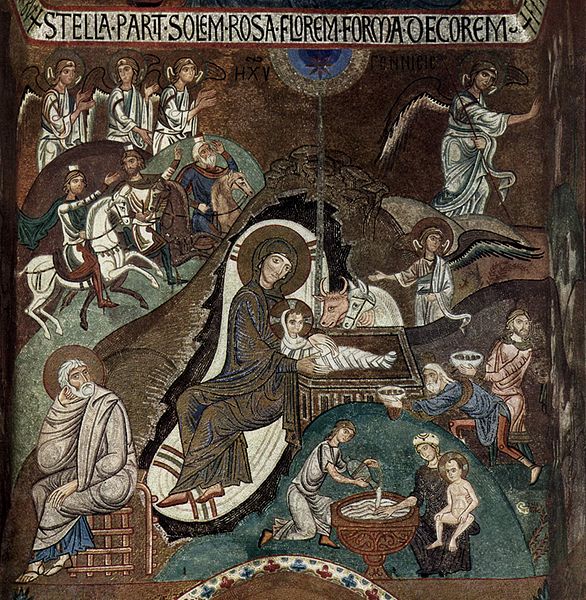
Unknown Master, Nativity Scene in Cappello Palatina Palermo (1150)
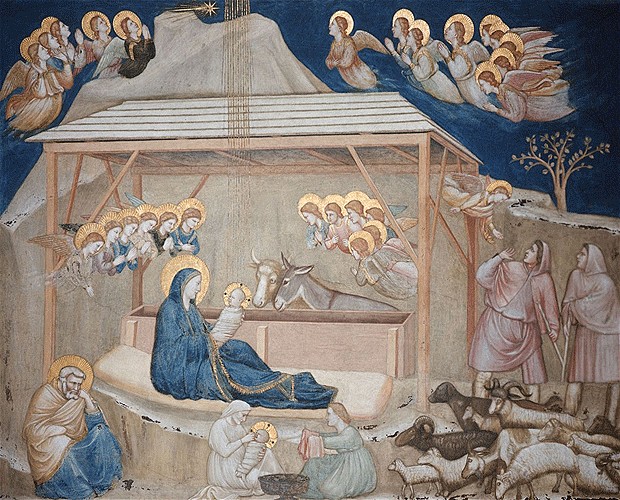
Giotto di Bondone, Nativity Scene in the Lower Church of San Francesco d’Assisi (1304 und 1306)
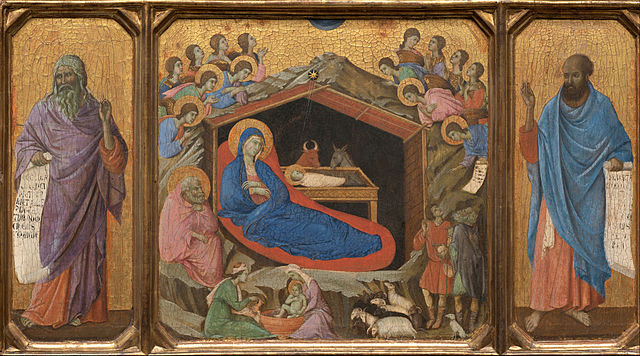
Duccio di Buoninsegna, The Nativity with the Prophets Isaiah and Ezekiel (1308-11)
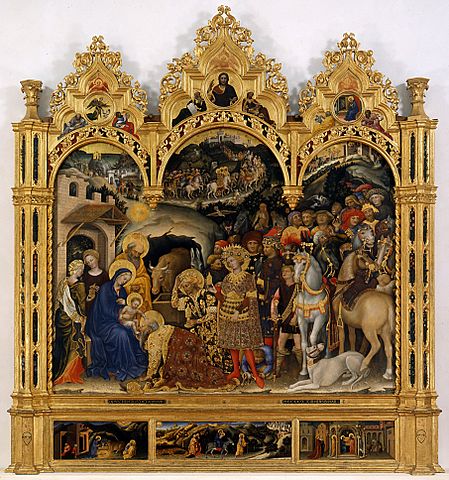
Gentile da Fabriano, Adoration of the Magi (1423)
Is this some Dan Brown shit? Or is Dan Brown so shit that he inoculates people against the notion artists once felt compelled to leave breadcrumbs of truth for those of us searching for it within the bamboozled future. Truth and misdirection take on similiar forms for good reason.
Ishtar, the goddess of Babylon who was associated, among other things, with sacred prostitution and virgin priestesses, had a bull which was torn apart > Dionysus, who was worshipped as a bull, was torn apart and eaten > Bacchus, the Roman name for Dionysus, was also a bull torn apart and eaten, and this was one ritual practised by the Cult of Mithras, whose namesake was often depicted slaying a Bull just like Gilgamesh did Ishtar’s. > Cryptic inclusions of a bull at the birth of Jesus, even though one isn’t mentioned in the biblical account.
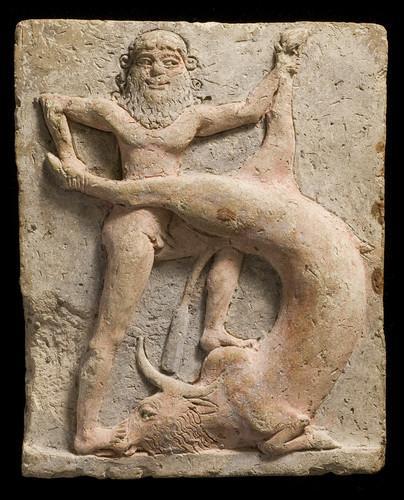
Artifact of Gilgamesh killing bull
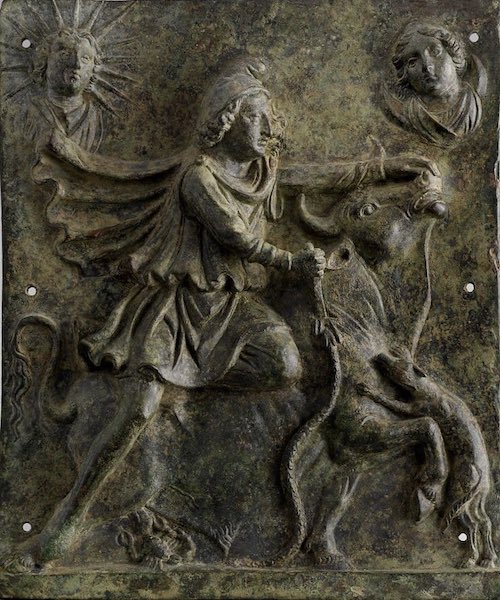
Artifact of Mithras killing bull
To take a shot in the dark, the Virgin Mary is the Babylonian Ishtar, an earth mother archetype. Jesus is her heavenly bull, a dying god archetype. Though more broadly, he was the bukkake child of a greater linage of religious traditions flowing together into a single image.
During the course of the Roman Empire it would seem that religious traditions, once worshipped collectively, appeared to have deviated along class lines. A monotheist religion was created for the working class masses. It had an extremely rigid and clearly defined moral doctrine to moderate internalised control of behaviour, while also placating them of animosity towards the rich. This is the notion of eternal damnation, that the rich are eternally damned, that it doesn’t matter their lives seem good and yours bad, for eventually yours will be better and theirs worse. The power of this psychology keeps people happy in their role.
On the other hand you had an Imperial Roman dynasty, presiding over society during this period that the mythology of Christian monotheism was created and introduced to those they ruled over. They were members of the Cult of Mithras, also called Sol Invictus later, and presumably were in keeping with traditions of the older more liberating and indulgent traditions, since made taboo in monotheism, as society would be too chaotic if a large number of people indulged in them. So they were kept and secret and exclusive.
And beyond this there existed a disordered third branch of experimental religious practises developed by sects of scholars studying within the library of Alexandra. This library, at its zenith during the Roman period though located in Egypt, was a cultural intersection of cross referenced study and examination which led to a whole range of spiritual hybrid belief.
It was here Gnosticism formed as a belief system held by a certain sect of scholars who adapted the belief system of Christianity according to the tenets of radical dualism, duality being that truth is found in the inversion of things.
The Gnostic's came to view the Christian doctrine as a control mechanism of moral enslavement, which it was. And because of this they viewed the moral tenets as shackles, which they were. Which meant that to liberate oneself from this enslavement was to break the shackles. And from this came the idea of gnosis, which was achieving freedom from moral obligation. And of course, they eventually followed such a line of thinking to its very end, and so begun a twisted tradition of rape, murder, and torture. It would be quite fair to call this certain sect of Gnostic practises Satanism, as their acts of moral indecencies were created as direct affronts to Christian morality, as opposed traditions predating the latter which had since become taboo.
As the Roman empire decayed, classical civilisation disintegrated into a decentralised gestation of Western civilisation, which reorganised itself into feudalism to survive the pervading onslaught of Islam into Europe. Religious traditions became isolated and dispersed across Europe in monasteries or other less formal groups. The institution of the Church slowly consolidated its power through coronation of a new monarchy government formed once siege artillery broke through the castle defence system, which had preserved the political autonomy of feudal lords to that point. The Church, being monotheists, fell into that dichotomy of good and evil whereby any religious practise which wasn’t good, good being Christ, must be evil, evil being Satanic. All sorts of religious traditions which had predated the Christian ones became threats to the political authority of monotheism, and so begun the witch trials and other such persecutions, which we now experience ourselves in the modern equivalent of terrorism, or more broadly speaking, extremist ideology. Though this isn’t to say certain Gnostic traditions didn’t persist, or that the Church was immune from indulging in such things itself.
And as one extreme tends to the shift towards its complete opposite, instead of mass witch trials these days, we have a complete denial for any such thing having existed, let lone still existing. The term satanic panic had become used to dismiss a whole number of strange things forming patterns, that is probably evidence to the continuation of age old esoteric religious traditions, which have existed outside of the mainstream norms for centuries.
The Roman period gave birth to three branches of divergent religious tradition: Gnosticism, Mathraism, and Christianity. Perhaps coincidentally, all three map to the social tiers proposed by Plato in hisThe Republic, these being guardians, auxiliaries, and producers.
The producers are working class masses, given a rigid moral code of Christianity. The auxiliaries are managerial political class responsible for the security of society and keeping the producers below them inline. They are given the varying degrees of the Mithraic mystery cult, possibly varying degrees of moral controls, which are stripped away as they transcend up through the cults degrees. And then finally there are the guardians, a small group of ruling elites who make macro decisions, recruited from the auxiliary class below them. Perhaps, recruited according to the transcendence of the the various degrees of Mithraism towards a kind of gnosis, beyond the moral code and in direct contrast to those bound to it beneath them, making them philosopher kings, ruling gods beyond moral burden to the consequence of their actions. Perhaps.
Elite Child Abuse Cults
Let us skip a chunk of history, as this piece is long enough, and pick up the pieces in the 18th century, where Sir Franchise Dashwood founded a social club for British elites called the Hellfire club, also known as the ‘Monks of Medmenham’ or ‘The Order of the Friars of St Francis of Wycombe’. Dashwood famously bore a nine chamber underground temple into a hill, atop of which stood a temple serving as the entrance leading down into what are known as the Hellfire Caves. These caves are one of the largest chalk excavation sites in the world. Of the nine chambers, one was named after Benjamin Franklin, a notable member; one was called the banquet room; while another was, and still is—inexplicably named the children’s cave. And it would appear the club was a continuation of Dionysus/Bacchus traditions:
“practice was rigorously pagan: Bacchus and Venus were the deities to whom they almost publicly sacrificed; and the nymphs and the hogsheads that were laid in against the festivals of this new church, sufficiently informed the neighborhood of the complexion of those hermits.” - Horace Walpole.
Bacchus(Moloch>Cronos/Saturn>Dionysus>Bacchus) and Venus(Inanna>Ishtar>Aphrodite>Venus).
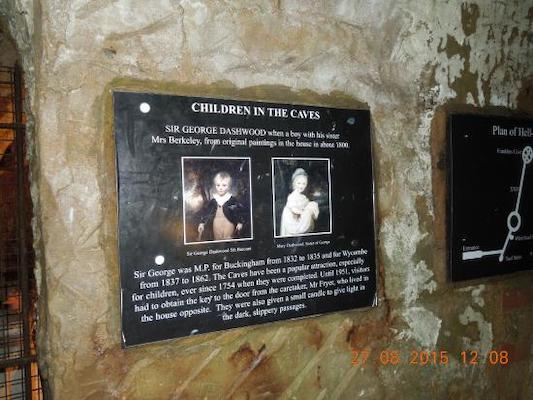
Taken at the Hellfire Caves
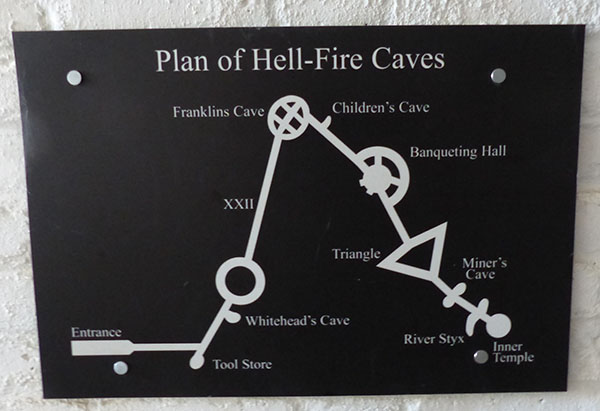
Map
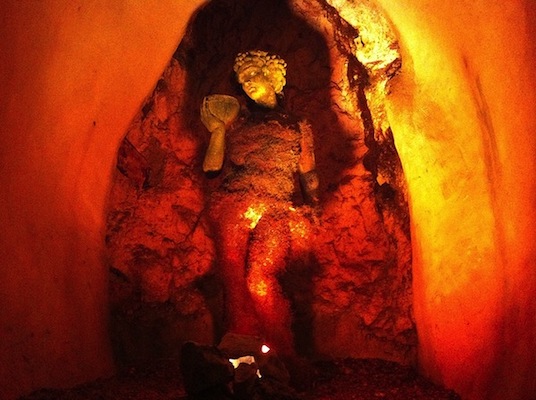
Statue to Bacchus inside caves, the Roman Dionysus
And crazy old Hunter Thompson was at it again, when he wrote an article in 1988, entitled The Hellfire Club:
“By the second half of the century, there was a whole new focus for the gentlemen's clubs—the worship of sex and extravagant public decadence. This was the time of the infamous Hellfire Club, which included among its inner circle the Prince of Wales, the Lord Mayor of London, Benjamin Franklin, the crazed Earl of Sandwich, the monstrous Earl of Bute, then prime minister of England. These people didn't fool around. They raised the orgy to an art form unknown since Caligula or even the fiendish Mongol hordes of Genghis Khan, who begat a long line of rapists and treacherous sex maniacs who were said to lament the fact that the human body had so few orifices to penetrate that they were forced to create new ones with their own daggers in order that the whole clan could swarm on a victim at once.”
The modern mainstream take on the Hellfire Club frames it as a practical jokers society, carrying out pranks on the public as if they had a youtube channel. So relax I suppose.
And the tradition of such a comedic society lives on in such contemporaries as the Wall Street Kappa Beta Phi, also called the Friar’s Club, which was founded in 1929. Its stated purpose is to "keep alive the spirit of the 'good old days of 1928–29’, which is in reference to a running gag they’ve been playing as a series of pranks called market crashes. Members have included Michael Bloomberg, Larry Fink, Wilbur Ross, and an endless number of other prominent names rounding out the leadership of Wall Streets top firms. There is the recent exposure of the sex slave and human trafficking cult NXIVM, which had been founded with seed capital by two heiresses of the Bronfman family. The ring was operated by a charlatan similar to Epstein, called Keith Raniere, who just like Epstein was regarded as rogue operator with no external power structure backing him.
Then there’s the neo-Templar cult, called the Order of the Solar Temple, which practised child sacrifice and most likely a series of mass killings made to look like mass suicides. And all this as recently as the 1980s, early 90s. This subject really is its own rabbit hole, but in briefly touching on it’ it should be mentioned that the Templar’s worshipped the Baphomet deity, which was in idolatry, took the image of a goat giving the same ‘As above, so below’ pose seen given by the ancient Mesopotamian deity Pazuzu, which was possibly the deity worshipped by the Roman cult of Mithras, another solar cult.
Of little notoriety is the story of Francis D. Shelden, a powerful Texas oilman and ‘philanthropist’, whose latter activities included a child pornography ring operated on North Fox Island during the 1970s. His operation likely included child murder too, possibly for snuff, as his ring was tangentially related to the Oakland County Child Killer, Christopher Busch. When the ring was exposed, Shelden fled to France, where Paedophilia isn’t so taboo amongst its women—such as its current first lady, and so married one for citizenship, which allowed him to spend the rest of his life in asylum between there and Amsterdam.
In Brussels during the 1990s there was a child rape and murder cult involving a serial killer called Marc Dutroux, closely linked to a number of high profile Belgium politicians, who attempted but failed to cover things up, and over 300,000 protesters took the streets.
In Italy there were the ‘Bunga Bunga’ parties attended by its Prime Minister, Silvio Berlusconi, that involving under-aged prostitutes.
In Argentina, a former model named Natacha Jaitt was found dead shortly after going public with allegations of a child sex ring involving high profile people in country. She publicly stated her death she would not be a suicide before she was found to have committed suicide.
Back to England and there’s the Westminster paedophile dossier, but also the Profumo affair back in the 60s, which involved a man called Stephen Ward hosting sex parties on the estate of Lord Astor, while also pimping out young girls to high profile politicians and European royalty. And if this sounds similar to the Jeffrey Epstein ‘scandal’, the icing on the cake is that Stephen Ward died of an ‘apparent suicide’ during his trial.
There’s the Finders cult and Franklin Cover-Up cases in the USA too. Where child sex and murder rings are operated in connection with those of great institutional authority at almost endemic levels, all while sweeping it beneath the rug with broad brush hoax hoaxs like the “satanic panic”. To understand what is happening one must go beyond corporate media, who are the culprits, and turn to the grassroots of those earlier periods, that were trying to blow the whistle on this stuff: Alternative Views: Boys for Sale
The two men being interviewed are Dr Tom Philpott and Mark Mckinnon, and what they outine, mostly Philpott, is the existence of an interstate child trafficking ring in the United States perpetrated by the political and business elite. The two men would have very different fates. Tom Philpott kept with his convictions and would eventually be found dead in his home of what was ruled a suicide. Mark Mckinnon on the other hand seems to have dropped his, as he is now a media personality on the inside access poltics show, The Circus.
So what the fuck is going on here? Relax it’s just a prank?
These cases could be isolated oddities, a pattern of coincidence, or they could be symptoms of a cultural tradition perpetuated esoterically and parallel to others celebrated in the open by the masses, such as Christmas. Which finally brings us to Stanley Kubrick’s Eyes Wide Shut, which is a Christmas movie if nothing, that just so happens to bleed into secret societies, ritual prostitution, a dead prostitute, and other themes all laced up in subliminal messaging ripe for the picking by those with the right kind of paranoia. And no one reads this far anyway, too many words, not enough meme, so it’s safe to skinny dip in the deep end of ideas without pissing in the shallows.
EWS is an adaptation of the 1926 novella, Traumnovelle. The plot of the book and film are pretty much the same. However, Kubrick did change the narrative to be set in a different time and place, from Austria during Carnival, to New York leading up to Christmas. In doing this Kubrick projected New York high society and Christmas onto the preexisting narrative. Not changing much but the context. And it’s all about context.

the Star of Ishtar
The Christmas party at the start of the film is set inside the Ziegler townhouse, which is decorated with eight-pointed stars. There are more eight pointed stars than any other decoration. The eight-pointed star, as we know, is the star of Ishtar, who was the patron goddess of ancient Babylon. We also know the rites of Ishtar involved rituals of sacred prostitution and sex magic. We also know these rites were apart of the Babylonian festival called Zagmuk, which was held during December, and probably also Sacaea which was held in June/July.
The host of the Christmas party is an oligarch named Ziegler, presumably in finance, who we later learn is a member of the secret society partaking in a strange ritualistic orgy using prostitutes. So Kubrick made the following associations:
- between the Star of Ishtar and a Christmas party hosted by a financial oligarch named Ziegler.
- between Ziegler and secret society practising sacred prostitution rituals later in the film.
It’s reasonable to conclude this is a conscious association between contemporary financial elites of New York, sacred prostitution rites of Ishtar, and Christmas time.
Kubrick has made pretty clear cut associations between oligarch celebrations and Canannite/Mesopotamian civilisation before. In The Shining he explicitly associates the overlook hotel as a retreat formerly frequented by the ‘jetsetters’, which is slang for an internationalist cosmopolitan high society. And Kubrick ends the film with that famous shot slowly zooming into that elusive photograph on the wall. A real photograph Kubrick found in the BBC archives, which he had Jack Nicholason’s head pasted onto. The photograph is an Oligarch celebration, dated 4th of July 1921; June/July being the period when the Babylonians held the festival Sacaea; with its central figure—on which Nicholason’s head is pasted onto—making the “As above, so below” gesture. A gesture associated with both the Baphomet deity worshipped by the Templar’s, but much earlier then that, with the deity Pazuzu, featured in The Exorcist, and whose idol is dug up during archaeological dig set in Iraq, which modern day Babylonia. And Kubrick isn’t the only celebrated filmmaker to make an association between Ishtar and high society. In Fritz Lang’s Metropolis, a ball room of high society men are shown mesmerised by the dance of The Whore of Babylon, a biblical moniker for Ishtar. Moloch also features in the film, but as a Marxist allegory depicting labour being fed into the flames of production. Granted, the Germans did have a certain affinity for Babylon, having stolen quite alot of its ruins from Iraq over the years to house in its museums.

Dance of the Whore of Babylon, Metropolis 1927.
Things only get weird from here. The films orgy sequence was shot within a mansion Kubrick used a hybrid of two locations to film. For interior shots he selected Elveden Hall, which is the residence of the Duke and Dutchess of Iveagh of the Guinness family. The Dutchess of Iveagh, before marrying into the Guinness family was just called Clare Hazell. And this is where things get weird, Clare Hazell just so happened to work for none other than Jeffrey Epstein before being introduced to her husband, Edward Guinness. On top of this, the exterior shots of the mansion are of Mentmore Towers, which had been a famous Rothschild Estate. And it is Lynn Forester de Rothschild, that as far as this website is concerned given the available evidence, WAS the primary power backer behind Jeffrey Epstein’s operation.
Kubrick also hired New York Post crime reporter Larry Celena to write an article shown in the film, which reports the death of one of the women used in the sacred prostitution ritual.

There can be read the lines, “She had many important friends in the fashion and entertainment worlds.”, “After being hired for a series of magazine ads for London fashion designer Leon Vitali, rumours began to swell of an affair between them.”
This is an association between the dead woman used in the sacred prostitution ritual and the fashion industry, and particularly a fashion designer named Leon Vitali. Leon Vitali is the name of a production assistant who worked on EWS, but he also appears in the credits as the actor who played the red cloaked figure leading the sacred prostitution ritual at the mansion.

Leon Vitali = Red Cloak
When you put this all together contextually, what you get is a group of New York financial elites, who associate Christmas with the Babylonian goddess Ishtar, meeting as a secret society to conduct sacred prostitution rites, within the actual estate Jeffrey Epstein’s former assistant lived in, using models supplied by the fashion industry.
And we haven’t even gotten to subliminal messaging in the film. All of this is overt. The associations are clear and not at all ambivalent. You can see the star of Ishtar. You can see the ritual of sacred prostitution. You can see the article linking the dead prostitute to a fashion designer. You can see the fashion designer linked to the red cloaked man conducting the ritual in the credits. Call it synchronicity, or maybe Kubrick didn’t have to know to understand.
However, in taking this a step further, we will go, and rightfully so, in a completely paranoid direction to entertain an idea, that perhaps, Kubrick also, very subtly alluded to another, much more taboo custom, concerning another Babylonian tradition, that of the child sacrifice substitution.
Bill is a doctor, an archetype of the highly specialised professional class. He thinks he is very knowledgeable, but lacks a general understanding for things. Which is to say naive. This is demonstrated at the Christmas party twice in dialogue:
- When Ziegler greets Alice and Bill, he thanks Bill for sending him to a specialist about his elbow. Bill knew nothing about the elbow, only which specialist would did. This motif is later repeated when Milich, costume store owner, seeks Bills advise about his balding, and Bill responds by telling him to speak with a hair specialist.
- When Bill is flirting with the two models, after mentioning his profession, one of them gives the line “they(doctors) always seem so, knowledgeable. ” to which Bill responds “Doctors are very, knowledgeable”.
Bill’s lack of understanding is put on further display when these models ask if he “wants to go where the rainbow ends”. He doesn’t know. Eventually he/we discover what it means in the costume shop, as there’s a room with a rainbow above it. It is within this room the owners underage daughter has been caught having sex with two Japanese men. But even then, Bill doesn’t fully understand what it means, as the owner pretends this was happening behind his back. Bill only learns upon returning the costume, that the owner was actually prostituting his daughter out when she is in turn offered to him. This is where the rainbow ends, organised child prostitution.

Where the rainbow ends
It may be something that Rockefeller plaza is also mentioned by one of the models at the Christmas party who mentions the rainbow. There is a famous high society ballroom located in Rockefeller plaza called the Rainbow Room. Here a band called Ray Noble and his orchestra played as resident musicians throughout the 1930s. A song they recorded in 1934, called ‘Midnight, the stars and you’ , is the song playing in the final shot of The Shining. The one zooming into the photograph.
During the Christmas party Bill is also strongly associated with the service class, not the high society guests. He has three interactions which aren’t with Alice. The first with his old friend Nick Nightingale, a pianist who gets quickly ushered away from the conversation by his boss, who needs him for something. The second is with the two models, and we know what they are used for, as Bill is quickly ushered away from this interaction, much in the same way as his friend Nightingale was, to attend to another model overdosed upstairs in Ziegler’s bathroom. These three are:
- Interaction with party entertainment, a musician.
- Interaction with party entertainment, two models.
- Attending to the needs of the party host.
Throughout the film Bill flaunts both money and his status as a doctor. This is behaviour associated with people culturally unfamiliar with status and wealth. It is new money culture constantly trying to avoid being mistaken from whence it came. Old money culture, which has no insecurities over its status, having been born into it, behaves differently.
So Bill is a young naive doctor obsessed with his credentials and money, servicing the needs of a social class above his. And he is who we follow the films narrative through. Trying to make sense of the film through Bill is fruitless, because he is naive.
But Bill is married to his complete opposite, Alice. Who is the key to understanding this intrepretation of the film.
While Bill interacts with other members of the service class at the Christmas party, Alice interacts with a Hungarian oligarch. Through this interaction we learn Alice is familiar with Ovid’s The Art of Love, which indicates she has ‘studied the classics’. That she managed an art gallery, which means she laundered oligarch money. And that she fits in well with the class above her husbands own.
Bill is naive new money, his wife Alice is wise old money. Their connection to high society isn’t through Bill, but through Alice. The links here are subliminal, and if real, shouldn’t have to be given with any exposition. So what is the connection Alice has to this higher class?

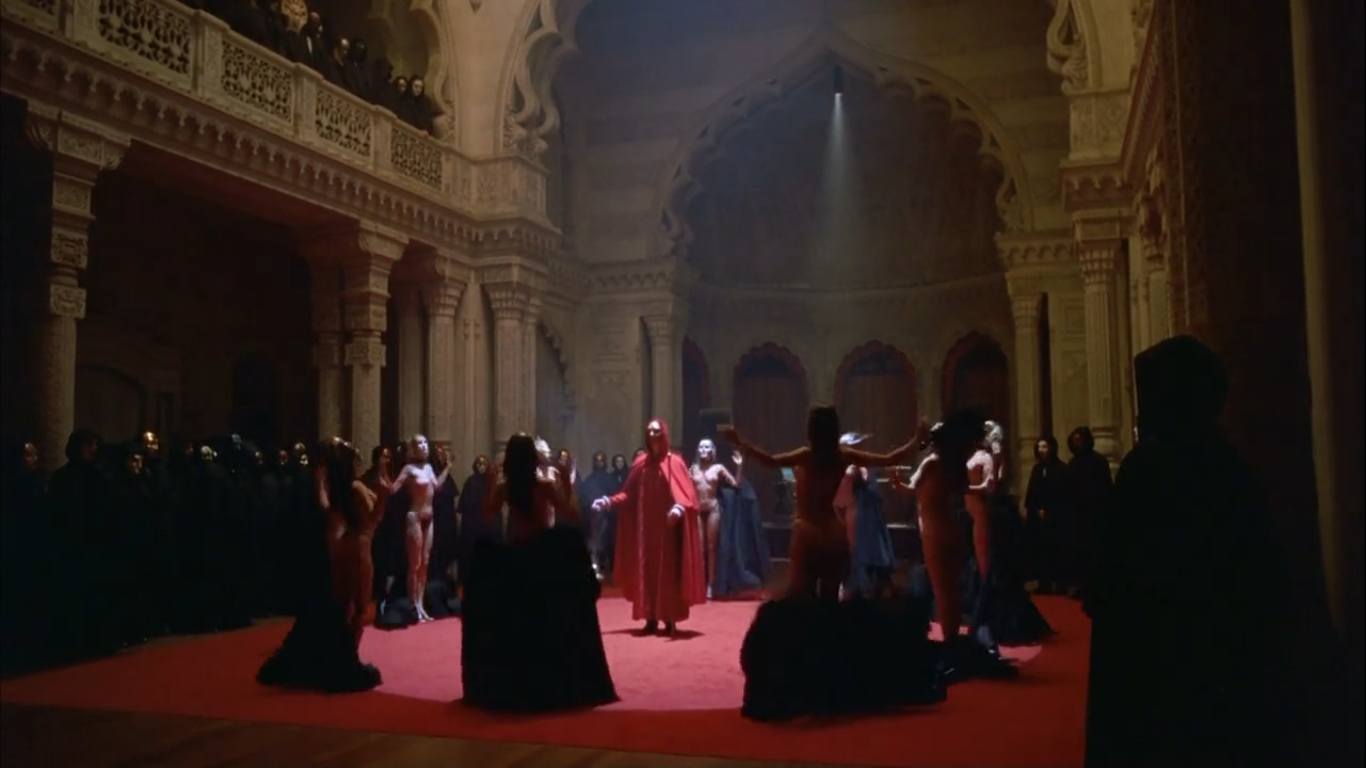
These first four shots are sequential.





These are time lapse shots collectively making up a montage of Bill and Alices day, eventually leading into a scene of Bill watching football on tv. Alice asks if they should wrap the rest of the Christmas presents. Bill replies they should do it tomorrow, and then the football announcer on TV can be heard saying “and here’s the handoff” just before the scene cuts. Moving on. . .

Two men beneath a statue of Cupid & Psyche at the base of a staircase during the Christmas party. Bill is led past as part of service class.
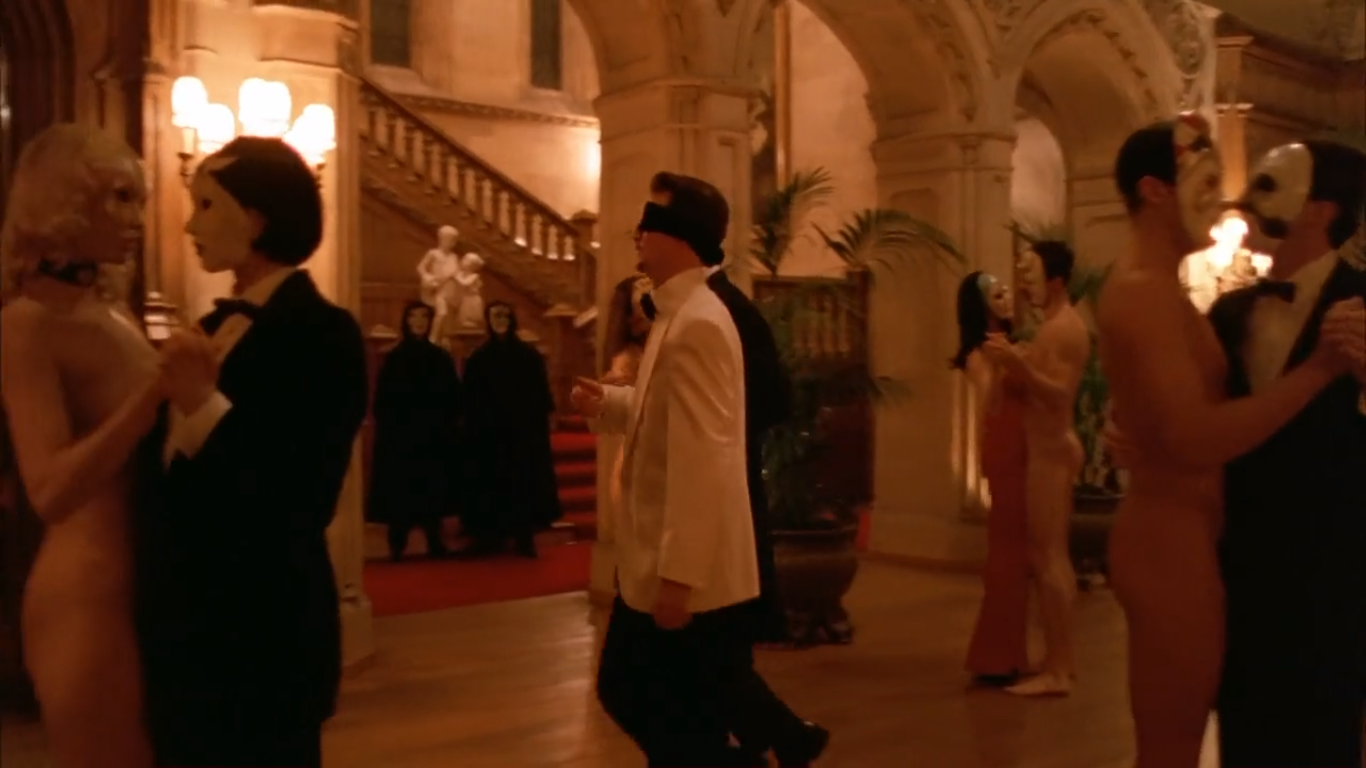
Two figures beneath a statue of children at the base of a staircase during the orgy. Bill's friend Nick is led past as part of service class.

The same two men underneath the statue at the Christmas party, at the toy shop. Stuffed lions on the shelves next to Alice.

Stuffed lion on the bed next to prostitute.

Final shot of daughter, before she turns away and follows the two men.
The final lines spoken
Alice ‘And you know, there is something very important we need to do as soon as possible’
Bill ‘What’s that’
Alice ‘fuck’
But. . . she isn’t interested in fucking Bill.
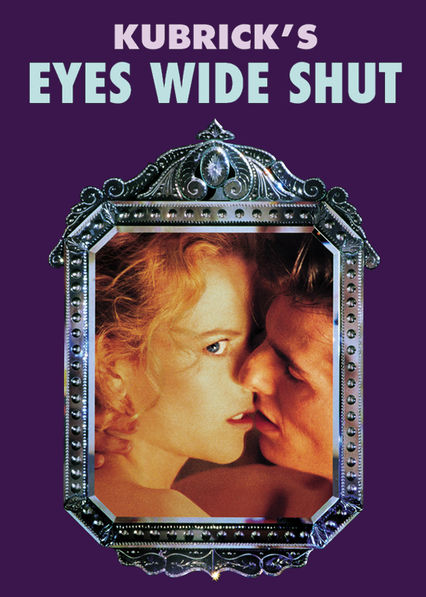
Not interested

Not interested

Not interested
She thinks it's important they should fuck, not to have sex, but to procreate. And she thinks this because, she has just given away their only child.
Refs:
The Transformations of a Goddess: Lillake, Lamashtu, and Lilith, Wendilyn Emrys, page 7.
The Golden Bough, James G. Frazer, 1981 edition published by Avenel Books.
Evolution of Civilisations: An introduction to historical analysis, Carroll Quigley, Second Edition 1979 printing by Liberty Fund.
Carthaginians sacrificed own children, archaeologists say., The Guardian.
The White Goddess, Robert Graves, Farrar Straus and Cudahy, 1948.
https://theoverlookhotel.com/post/33841162601/the-original-unaltered-period-photo-into-which,
https://www.theguardian.com/world/2012/nov/20/pope-nativity-animals